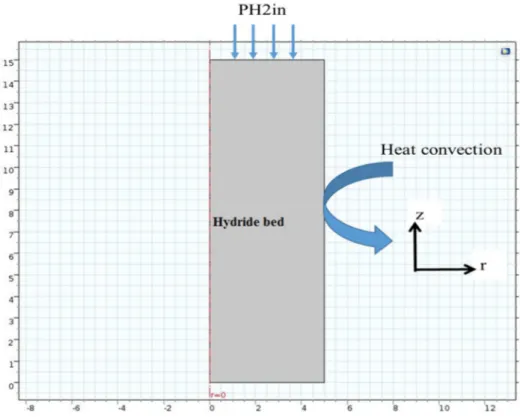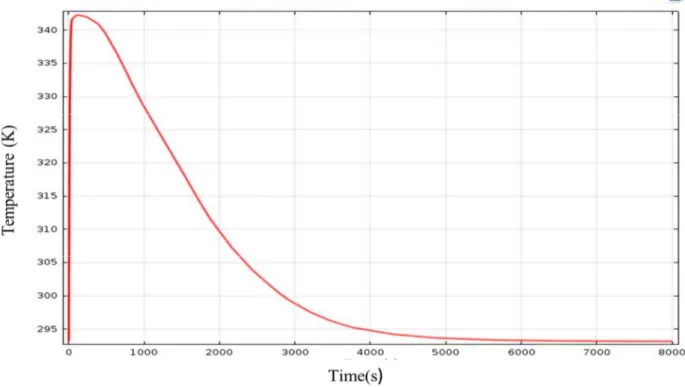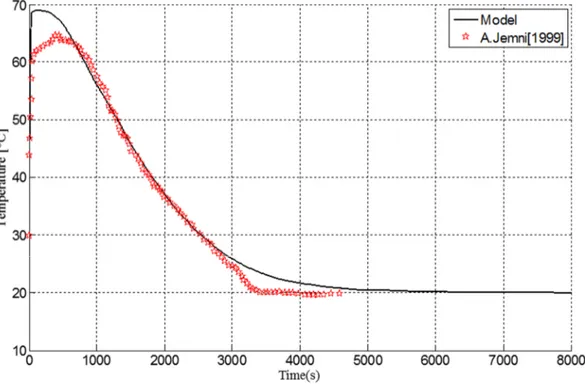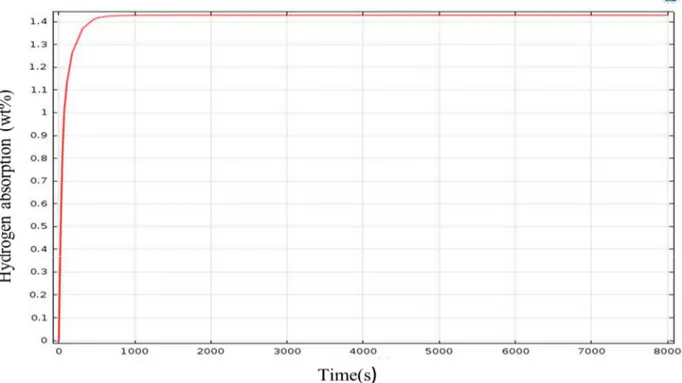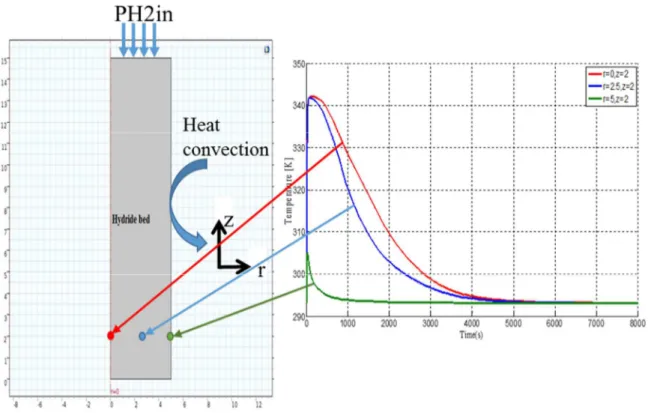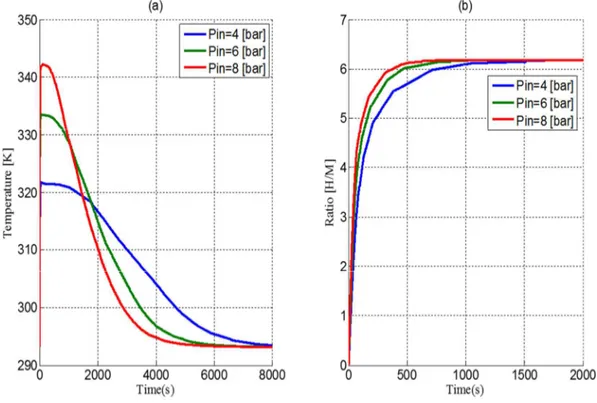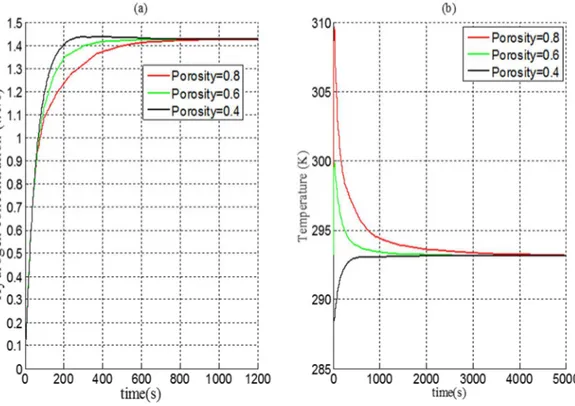HAL Id: hal-01359466
https://hal.archives-ouvertes.fr/hal-01359466v2
Submitted on 11 May 2017HAL is a multi-disciplinary open access archive for the deposit and dissemination of sci-entific research documents, whether they are pub-lished or not. The documents may come from teaching and research institutions in France or abroad, or from public or private research centers.
L’archive ouverte pluridisciplinaire HAL, est destinée au dépôt et à la diffusion de documents scientifiques de niveau recherche, publiés ou non, émanant des établissements d’enseignement et de recherche français ou étrangers, des laboratoires publics ou privés.
Influence of the key parameters on the dynamic
behavior of the hydrogen absorption by LaNi5
Djafar Chabane, Fabien Harel, Abdesslem Djerdir, Mona Ibrahim, Denis
Candusso, Omar Elkedim, Nouredine Fenineche
To cite this version:
Djafar Chabane, Fabien Harel, Abdesslem Djerdir, Mona Ibrahim, Denis Candusso, et al.. Influence of the key parameters on the dynamic behavior of the hydrogen absorption by LaNi5. International Journal of Hydrogen Energy, Elsevier, 2016, 42 (2), pp.1412-1419. �10.1016/j.ijhydene.2016.06.110�. �hal-01359466v2�
Influence of the key parameters on the dynamic behavior of the hydrogen absorption
by LaNi
5D. CHABANE1,2, F. HAREL1,5, A. DJERDIR1,2, M. Ibrahim 1, D. CANDUSSO1,5,
O. ELKEDIM1,5 N. FENINECHE 1,3
1 FCLAB Research Federation (FR CNRS 3539), 90010 Belfort Cedex, France 2IRTES-SET, UTBM, 90000 Belfort CEDEX, France
3University of Technology of Belfort-Montbéliard 4IRTES-LERMPS, UTBM, 90000 Belfort CEDEX, France
5FEMTO-ST (UMR CNRS 6174) MN2S department / University of Technology of Belfort-Montbéliard 6Université de Lyon, IFSTTAR / AME / LTE, 25 avenue François Mitterrand, Case 24, Cité des mobilités, F-69675
Bron Cedex, France.
7IFSTTAR / COSYS / LTN, 25 allée des marronniers, 78000 Versailles Satory, France.
E-mail address: djafar.chabane@utbm.fr
Abstract:
The hydride tank design is one of a technological issue for the rapid development and large-scale of fuel cells. In this paper, a two-dimensional model of a closed metal–hydrogen reactor is presented. The temperature and the pressure temporal evolutions within the reactor as a function of time are reported. In order to determine the parameters to optimize a fast kinetic and optimal heat exchange, impact of the supply pressure, the porosity and the dynamic viscosity have been studied. The results show that the effect of these parameters are crucial factors for an optimized tank design.
Keywords: Hydrogen storage, hydride, Modelling, fuel cell.
Introduction:
The metal hydrides provide a safe way of handling hydrogen. This is the most important point for hydrogen transportation and storage using metal hydrides. Therefore, an important number of studies have been carried out to develop this technology, and to improve the use of hydrogen in different applications such as fuel cell [1], heat pump [2], heat transformer [2], hydrogen compressor [2] and batteries [2]. This technology is great interest for transport application where the security, the weight and the volume are crucial factors when designing the vehicle. In order to describe the absorption and desorption process in porous media, various mathematical models have been reported on the heat and mass transfer [3-8]. A particular case, namely the hydride bed, have been studied in multiple investigations. Muthukumar P. et al [9] performed a parametric study of a hydrogen storage device in MmNi4.6Al0.4, they showed that the increase in the entire heat transfer coefficient is not of a positive impact. Most of the presented models in the literature are based on symmetric axis tank 2D modeling, the first two-dimensional numerical studies of a hydrogen reactor was performed by A. Jemni et al [10]. Their results showed the importance of the geometry, the pressure at the inlet and the choice of the cooling temperature. Dogan et al [11] presented a mathematical model for the storage of hydrogen in solid form. As a conclusion of their work, they proved that rapid load requires efficient cooling
which is directly related to the feed rate. In another study carried by K. B. Minko et al [3], the authors perform the analysis of a model of a cylindrical metal hydride tank. They conclude that the concentration gradient in the bed is the main driving force of the flow of hydrogen. A. Kumar Phate al [12] have added an experimental validation of numerical simulations of hydrogen storage tank with metal hydrides, their goal was to obtain a better performance against the objectives set by a stationary cogeneration system. A numerical study of the heat and mass transfer in annular reservoir has been conducted in [13]. The results showed that the use of vanes improves the heat transfer and consequently an improvement of 40% of the time required for storage versus the case without fins. A computational fluid dynamics (CFD) model for the simulation of the storage of hydrogen in an activated carbon tank was described by F. Ye, et al.
[15], this model showed that the amount of hydrogen adsorbed is greater than the one of the compressed hydrogen gas. A 3D modeling under Comsol & Multiphysics of a cylindrical tank was carried out in [16]. In order to determine the parameters of the hydride to optimize for optimal storage, their results showed that the most relevant parameters optimized are the load pressure, the permeability and thermal conductivity of the hydride. Brown et al. [17] developed a mathematical model describing the process of hydrogen storage in a commercial reservoir loaded with a metal hydride type AB2. The simulation has been carried out using Matlab. The obtained results allowed them to validate the experimental results and the simplifications made for reproducing the process of absorption and desorption of hydrogen by hydride.
The present work is an extension of that reported in a previous paper [22] and completes the study of the system with data acquired during the experimental test. In the previous study the tank is regarded as a black box, the only experimental study does not allow access to the development of all system parameters. In particular, the evolution of the temperature within hydride bed upon absorption or desorption. The aim of this study is to determine the most parameters to optimize for a hydride tank. A simulation model was developed for analyzing the effect of certain parameters on the thermal behavior of the tank. To carry out the simulation, a mathematical model was done based on the Mass Conservation, momentum conservation and energy balance. The material used is LaNi5.
2. Numerical model of the reactor
The physical model of the metal hydride reactor considered in this study is presented in figure 1. The reactor consists of a cylindrical container of radius R=10cm and height H=15cm. the considered geometry is axisymmetric half of the domain. It is surrounded by an aluminum frame in order to uniform the temperature. The cooling is performed by natural convection. The hydrogen is injected into the tank from the top at PH2inj pressure 8bar. The temperature is maintained constant at the inlet of the tank. The model is integrated and solved using Comsol- Multiphysics 5.0.
Fig 1: The geometry of the model
To simplify the model, the following assumptions are considered: • The gas phase is ideal, from a thermodynamic point of view; • The media are in local thermal equilibrium between gas and solid; • The solid phase is isotropic and has a uniform and constant porosity; • The radiative transfer in the porous medium are neglected;
• The reactor is considered in two dimensions; • The flow is laminar (validity of Darcy’s law);
• Hydrogen is supplied at the inlet to the bed at a known constant pressure P=8 bar. The establishment of mathematical model describing the transfer of the heat and mass in porous media is directly inspired by methods that are traditionally used in mechanics of the continuous media. These methods consist of determining the local expression of conservation laws:
• Mass Conservation; • Momentum Conservation; • Energy conservation.
2.1. Energy equation
Add to the following assumption, the convective transfer can be neglected as well [19-21], also the temperature of the gaseous phase and the solid phase in the bed are similar (i.e local thermal equilibrium), the governing energy equation can be written as:
+ = + (1)
Where Sm is the source term given by
= ( − )|∆ | (2)
The effective heat capacity and effective thermal conductivity of the hydride bed are expressed as:
!" #$$ = %!"%+ ( − ) !" (3)
&#$$= &%+ ( − )& (4)
2.2. Mass balance
In order to model the hydrogen flow, the amount of hydrogen absorbed/ desorbed is determined using the mass conservation.
For the gas, the mass conservation equation is:
%+ '()
%)*+% = − , (5)
For the solid, the mass conservation equation is:
( − ) = , (6)
%= -% /01 (7) The gas velocity is given by Darcy’s law:
)*+% = −23*****+ (8) "
Where:
K: The intrinsic permeability of the porous medium (m2) μ: Dynamic viscosity of the fluid (Pa)
In order to validate Darcy law it is necessary to have a laminar flow, which is the case in porous media generally. The verification of this condition is done using the Reynolds number Re is defined as following:
0# =45) (9)
Where:
Q: flow rate [L / min]
L: the representative length of the flow [m] v: Kinematic viscosity
The permeability K depends mainly on the solid while the viscosity μ depends on the nature of the fluid. It is given by the Kozeny-Carman equation. It describes the permeability as a function of grain size and porosity [17]:
2 = 78( 9 )'"6 6 6 (10)
Where
dp: diameters (m).
ε: Environmental porosity.
As for the dynamic viscosity, the majority of the works done in the literature don't take into account the temperature dependence of the viscosity. This dependence is expressed using the law of Sutherland:
3 6(1) = 3 6(18) :18;!1;!< :181< = 6⁄
(11)
With :
µH2(T0) is the dynamic viscosity at T0
2.3. Kinetics reaction
The amount of the absorbed/desorbed hydrogen by the metal as a function of time is directly related to the rate reaction of the hydriding and dehydriding process. The absorption and desorption kinetics of a hydride indicate the speed with which the hydrogen is absorbed by the intermetallic. They are strongly influenced by the thermodynamic conditions in the tank. In absorption case:
= ?#@" :−BA?< CD EFFGH ( II− I) (12)
In desorption case:
I =
J#@" :−BAJ<F9FFGG I (13)
Where Peq represents the equilibrium pressure that is given as a function of temperature. It is calculated using van’t Hoff equation [14] for absorption case.
CD :/#K/8< = L −M1 (14)
Where A and B are Van’t Hoff constants having values 12.919 and 3704.4 respectively [12]. The thermophysical proprieties of the LaNi5 and hydrogen used to compute the model are listed
in table 1:
Parameters Symbol value Initial pressure P0 1 [bar] Activation energy Ea 21170 [J/mol] Universal gas constant R 8.314 [J/mol/K] Density of the solid at
saturation state
ρ_ss 8520 [kg/m^3]
Density of the solid ρ_0 8400 [kg/m^3] Enthalpy of formation ∆H 30 [KJ/mol] Specific heat of the
solid
Cps 419 [J/kg/K] Specific heat of the H2 Cpg 14890 [J/kg/K] Thermal conductivity of the solid λs 2.4 [W/m/K] Thermal conductivity of H2 λg 0.16 [W/m/K] Dynamic viscosity of H2 µo 8.76 10-6 [Pa*s] Reaction constant Ca 59.9 [1/s] Inlet temperature of hydrogen T0 293[K] Sutherland constant c0 72 Porosity ε 0.5 Inlet pressure of the
hydrogen
Pin 8[bar] Heat transfer
coefficient
h 1650[W/m^2/K]
Table1: Thermo physical properties of LaNi5, H2 and constant used in the analysis [14]
Initial and boundary conditions:
Initially at t=t0, the temperature, the hydride density and the pressure in the reactor are assumed to be constant:
So, for = 8⇒ O
1( 8, Q, R) = 18
( 8, Q, R) = 8
/( 8, Q, R) = /8
The boundary conditions are expressed as
r=0 ST(0, V)
SW = 0; ∂T(0, z)∂r = 0
r=R /(0, R) R = 8; /(0, R)R = 8; 1(0, R) Q = ](1 − 1#@ ) z=H F(^, _) ^ = 8; 1(Q, )Q = 8 3. Results
Figure 2 shows the average temperature as a function of time, which increases and reaches rapidly the maximum of the temperature. This increase of temperature is caused by the hydriding reaction of the intermetallic. After this rapid increase, the temperature decreases gradually up to reaching the cooling temperature to 293K. The system returns to its equilibrium state taking about one hour under the action of the convective exchange with the outside. The cooling time for the simulated reactor is quite high due to the low thermal conductivity of the hydride and the non-optimized thermal exchange.
Fig 2: Bed temperature vs. time during absorption
Fig.3 shows the time evolution of the temperature in the center of the hydride bed. Our results are reasonably comparable to those published in [19].
Fig 3: Thermal behavior
In figure4, the evolution of the amount of hydrogen absorbed by the hydride versus time is represented. It is observed that the rate increase rapidly, due to a strong pressure gradient between equilibrium pressure and pressure applied, then the absorption rate stabilizes at a rate of 1.42% for the alloy concerned which is related to the pressure applied to its input.
Fig 4: Concentration vs. time during hydrogen absorption
Fig. 5 shows the temperature evolution in the metal bed in three different positions within the reactor. The temperature of the cooling fluid and the inlet pressure are kipped constants (Tf =20 °C and Pin = 8 bar). The temperatures show a rushed rise in the metal bed at the beginning, due to the exothermic hydrogen-metal reaction, then decrease gradually with the reaction kinetics decay. However, the time to return to thermal equilibrium is different according to the distance. This is due to the high gradient of temperature and low thermal conductivity of the bed of hydride. The simulation results are in good agreement with the experiments results showed in [19], conceding that the model can be used for further investigations of the transient thermal fluid behavior in MH reactors.
Fig 5: Bed temperature vs. time for various positions in the reactor
4. Effect of the operating pressure
Figure 6 depicts the temporal evolution of the temperature and the atomic ratio within the reactor at different supply pressures at constant cooling temperature (20°C). As shown in figure 5a, the increase of the supply pressure makes the return of the system to the equilibrium state faster. It is also observed that, the rate of absorption reaches the maximum quickly for a high supply pressure Figure 5b.
Fig 6: Effect of the supply pressure
It can be noticed that the supply pressure has a direct impact on the kinetics but also on the heat exchange and the temperature gradient.
5. Effect of the Porosity:
Figure 6 shows the influence of the porosity over the hydrogen concentration and on the temperature of the hydride. It is noticed that as the porosity increases the time to attain the equilibrium state is increased (fig7 (a)). Indeed, at low porosity, the effective conductivity is high, hence the thermal gradient is lower and the thermal evacuated is faster (fig7 (b)).
Fig 7 Porosity effect
6. Conclusion
In this paper a numerical study is carried out for transient two-dimensional heat and mass transfer in cylindrical metal hydride bed. The numerical model developed takes into account the chemical aspects, thermodynamic, thermal fluids behavior of these reservoirs. The results showed a significant and rapid production of heat to the top of the absorption process of the hydrogen within the metal hydride. These temperature gradients between the center and the surface of the tank are axial and radial. The effect of different parameters such as supply pressure, porosity has been discussed and the results show that these parameters are crucial factors for an optimized tank design.
Furthermore, our results are in agreement with those available in the literature. This study should allow a design and manufacturing of optimal hydride tank for a better heat management between the metal-hydride tank and the fuel cell for drive-trains in automotive application.
References:
[ 1] M.V. Lototskyy, M.W Davids, I Tolj, Y.V. Klochko, B.S. Sekhar, S. Chidziva, F. Smith, D. Swanepoel, B.G. Pollet “Metal hydride systems for hydrogen storage and supply for stationary and automotive low temperature PEM fuel cell power modules International Journal of Hydrogen Energy, Volume 40, Issue 35, 21 September 2015.
[ 2] Samuel L. weeks “Review of the prospects for using hydrogen as a fuel source in internal combustion engines”. UCL Energy Institute, University College London April 2015."
[ 3] K. B. Minko, V. I. Artemov, and G. G. Yan’kov, “Numerical simulation of sorption/desorption processes in metal-hydride systems for hydrogen storage and purification. Part I: Development of a mathematical model,” Int. J. Heat Mass Transf., vol. 68, pp. 683–692, Jan. 2014.
[ 4] Ali Boukhari, Rachid Bessaih “Numerical heat and mass transfer investigation of hydrogen absorption in an annulus-disc reactor” Int. J. Hydrog. Energy, Jun 2015
[ 5] T. Maeda, K. Nishida, M. Tange, T. Takahashi, A. Nakano, H. Ito, Y. Hasegawa, M. Masuda, and Y. Kawakami, “Numerical simulation of the hydrogen storage with reaction heat recovery using metal hydride in the totalized hydrogen energy utilization system,” Int. J. Hydrog. Energy, vol. 36, no. 17, pp. 10845–10854, Aug. 2011.
[ 6] K. B. Minko, V. I. Artemov, and G. G. Yan’kov, “Numerical simulation of sorption/desorption processes in metal-hydride systems for hydrogen storage and purification. Part I: Development of a mathematical model,” Int. J. Heat Mass Transf., vol. 68, pp. 683–692, Jan. 2014.
[ 7] G. Momen, G. Hermosilla, A. Michau, M. Pons, M. Firdaous, P. Marty, and K. Hassouni, “Experimental and numerical investigation of the thermal effects during hydrogen charging in packed bed storage tank,” Int. J. Heat Mass Transf., vol. 52, no. 5–6, pp. 1495–1503, Feb. 2009. [ 8] J. Nam, J. Ko, and H. Ju, “Three-dimensional modeling and simulation of hydrogen absorption in
metal hydride hydrogen storage vessels,” Appl. Energy, vol. 89, no. 1, pp. 164–175, Jan. 2012. [ 9] P. Muthukumar, U. Madhavakrishna, and A. Dewan, “Parametric studies on a metal hydride based
hydrogen storage device,” Int. J. Hydrog. Energy, vol. 32, no. 18, pp. 4988–4997, décembre 2007. [ 10] A. Jemni and S. B. Nasrallah, “Study of two-dimensional heat and mass transfer during absorption
in a metal-hydrogen reactor,” Int. J. Hydrog. Energy, vol. 20, no. 1, pp. 43–52, Jan. 1995.
[ 11] A. Dogan, Y. Kaplan, and T. N. Veziroglu, “Numerical investigation of heat and mass transfer in a metal hydride bed,” Appl. Math. Comput, vol. 150, no. 1, pp. 169–180, février 2004.
[ 12] A. Kumar Phate, M. Prakash Maiya, and S. S. Murthy, “Simulation of transient heat and mass transfer during hydrogen sorption in cylindrical metal hydride beds,” Int. J. Hydrog. Energy, vol. 32, no. 12, pp. 1969–1981, août 2007.
[ 13] M. Botzung, S. Chaudourne, O. Gillia, C. Perret, M. Latroche, A. Percheron-Guegan, and P. Marty, “Simulation and experimental validation of a hydrogen storage tank with metal hydrides,” Int. J. Hydrog. Energy, vol. 33, no. 1, pp. 98–104, Jan. 2008.
[ 14] F. Askri, M. Ben Salah, A. Jemni, and S. Ben Nasrallah, “Heat and mass transfer studies on metal-hydrogen reactor filled with MmNi4.6Fe0.4,” Int. J. Hydrog. Energy, vol. 34, no. 16, pp. 6705–6711, août 2009.
[ 15] F. Ye, J. Xiao, B. Hu, P. Benard, and R. Chahine, “Implementation for Model of Adsoptive Hydrogen Storage Using UDF in Fluent,” Phys. Procedia, vol. 24, Part B, pp. 793–800, 2012.
[ 16] A. Freni, F. Cipiti, G. Cacciola. “Finite element-based simulation of a metal hydride-based hydrogen storage tank”. International Journal of Hydrogen Energy, 34(20), 8574-8582.
[ 17] T. M. Brown, J. Brouwer, G. S. Samuelsen, F. H. Holcomb, and J. King, “Accurate simplified dynamic model of a metal hydride tank,” Int. J. Hydrog. Energy, vol. 33, no. 20, pp. 5596–5605, Oct. 2008.
[ 18] Model document French “https://perso.limsi.fr/jebali/Cours_LA218/Ecoulements_Visqueux.pdf.” . [ 19] A. Jemni, S. B. Nasrallah, and J. Lamloumi, “Experimental and theoretical study of ametal–hydrogen
reactor,” Int. J. Hydrog. Energy, vol. 24, no. 7, pp. 631–644, juillet 1999.
[ 20] A. Chaise, “Etude expérimentale et numérique de réservoirs d’hydrure de magnésium,” phdthesis, Université Joseph-Fourier - Grenoble I, 2008.
[ 21] G. Sandrock and G. Thomas, “The IEA/DOE/SNL on-line hydride databases,” Appl. Phys. A, vol. 72, no. 2, pp. 153–155, Feb. 2001
[ 22] D. Chabane, F. Harel, A. Djerdir, D. Candusso, O. ElKedim, and N. Fenineche, “A new method for the characterization of hydrides hydrogen tanks dedicated to automotive applications,” Int. J. Hydrog. Energy, Jan. 2016.
